Nuremberg Airport
| Nuremberg Airport Flughafen Nürnberg | |||||||||||
|---|---|---|---|---|---|---|---|---|---|---|---|
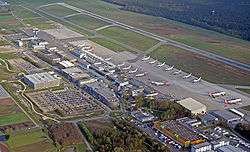 | |||||||||||
| IATA: NUE – ICAO: EDDN | |||||||||||
| Summary | |||||||||||
| Airport type | Public | ||||||||||
| Operator | Flughafen Nürnberg GmbH | ||||||||||
| Serves | Nuremberg, Germany | ||||||||||
| Elevation AMSL | 1,046 ft / 319 m | ||||||||||
| Coordinates | 49°29′55″N 011°04′41″E / 49.49861°N 11.07806°ECoordinates: 49°29′55″N 011°04′41″E / 49.49861°N 11.07806°E | ||||||||||
| Website | airport-nuernberg.de | ||||||||||
| Map | |||||||||||
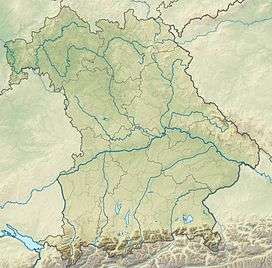 NUE Location of airport in Bavaria | |||||||||||
| Runways | |||||||||||
| |||||||||||
| Statistics (2013) | |||||||||||
| |||||||||||
Nuremberg Airport (IATA: NUE, ICAO: EDDN), German: Albrecht Dürer Flughafen Nürnberg, is the international airport of the Franconian metropolitan area of Nuremberg and the second-busiest airport in Bavaria after Munich Airport. With about 3.3 million passengers handled in 2013, it is Germany's 10th biggest airport. It is located approximately 5 km north of Nuremberg's city centre and offers flights within Germany as well as to European metropolitan and leisure destinations, especially along the Mediterranean Sea, on the Canary Islands and in Egypt.[3]
History
Early years

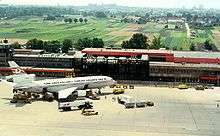
Nuremberg Airport was the first airport constructed in Germany after World War II. It was inaugurated on 6 April 1955.
In 1960, the number of passengers at Nuremberg Airport reached 100,000 for the first time and in 1961 the runway was extended from 1,900 to 2,300 metres (7,500 ft). In 1968, the runway was extended once again to its present length of 2,700 metres (8,900 ft), allowing jumbo jets to use it. On 12 July 1970, a Boeing 747 landed at the airport for the first time and attracted 20,000 visitors.
The apron was enlarged in 1977 and in 1981 a new passenger terminal with an observation deck and a restaurant replaced the previous building. In December 1986, the one million passenger mark was passed for the first time.
Development from the 1990s
In 1997/98, Air Berlin established a winter hub at the airport, making it the airline's second most important tourist interchange airport, after Palma de Mallorca.
The new control tower commenced operations in 1999 and the metro station was opened. In 2002, departure hall 2 was extended and a year later the cargo centre CCN2 with 6,500 m2 (70,000 sq ft) of storage space and 4,600 m2 (50,000 sq ft) of office space was inaugurated after one and a half years' construction.
In 2005 Nuremberg Airport celebrated its 50th anniversary with 45,000 visitors. The new transfer control terminal with a floor space of 8,500 m2 (91,000 sq ft) and a new main gate (Tor 1) were completed a year later in 2006. In addition, a fully automatic luggage sorting system was put into operation.
Nuremberg Airport has been voted "Best German Airport" by readers of the Business Traveller magazine consecutively since 2008.[4][5]
In April 2013 Air Berlin permanently shut down its winter seasonal hub in Nuremberg which had been maintained for several years.[6]
In December 2014 the airport was named after Albrecht Dürer, who was born in Nuremberg.[7]
In October 2016, Ryanair announced to open a base at Nuremberg Airport consisting of two aircraft while four additional routes will be inaugurated.[8] In the same month, Air Berlin announced to close its maintenance facilities at the airport due to cost cutting and restructuring measures.[9] Shortly after, Germania announced to open a new base at Nuremberg Airport consisting of one aircraft which will serve several new leisure routes.[10]
Facilities
Runway
The runway 10/28 is 2,700 by 45 m (8,858 by 148 ft).[2] Takeoff and landing of all current aircraft, including widebody aircraft (e.g. Boeing 747) or cargo planes (e.g. Antonov An-124 Ruslan) are possible. However, Nuremberg Airport is not licensed for the Airbus A380.
Starting in July 2009, the runway was refurbished gradually in several phases. The surfaces of the runway and taxiways were renovated using the latest technology. A new flare-path, drainage channels and a new electric ring surrounding the entire runway were added. In 2010, the runway was shortened to 2,300 m (7,500 ft) temporarily to allow construction to continue. In 2011, work on the centerpiece of the runway began. The work was completed in 2015.
The apron is 246,845 m2 (2,657,020 sq ft) in space and provides parking positions for 37 planes.
Terminal
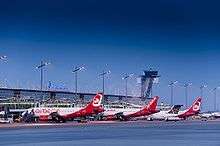
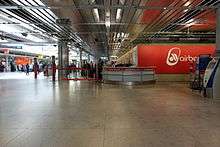
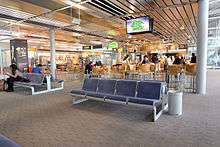
The passenger terminal consists of two departure halls and one arrival hall which are all linked landside and airside. The check-in area features 40 desks.
The extension of departure hall 2 was inaugurated on 30 April 1992 and was originally dimensioned for 2.8 million passengers per year. Now there is room for 5 million passengers per year. Daylight dominates the transparent construction made of steel and glass drafted by Nuremberg architects Grabow and Hoffmann. The construction phase took three years and cost about 100 million Deutsche Mark. The extension of the apron was included in the building costs as well as three modern air bridges. Today, there are five finger docks available.
On 25 January 2007 the newest addition, the Transfer-Control-Terminal (TCT) was opened. It not only serves as a capacity extension but it also allows for new legislation concerning security measures: since EU Regulation 2320/2002 airports have to make sure that non-EU passengers are controlled before continuing their trip to countries of the European Union and don't get mixed up with passengers who have already been checked.
Cargo center
In 1987, Cargo Center Nuremberg (CCN) was put into operation. When the Cold War ended and after the collapse of the Soviet Union, Nuremberg won back its central location in Europe. As a consequence Nuremberg Airport and air freight quickly gained in importance in the 1990s.
Nuremberg is also the economic and service metropolis of Northern Bavaria with approximately 150,000 companies and enterprises taking advantage of the locality of Nuremberg as a traffic junction of highways and railroads. The region's export share of 42% is remarkably high and above German average. In addition, several headquarters of internationally operating companies are located in the region, for example Siemens, Adidas, Bosch, Puma and Faber-Castell.
Due to the positive trend, Cargo Center II (CCN II) was built in 2003. Today, almost 13,317 m2 (143,340 sq ft) storage space and 7,000 m2 (75,000 sq ft) of office space is available at Nuremberg Airport. 107,123 tons of cargo were handled in 2010.
Control tower
Deutsche Flugsicherung (DFS), which is in charge of air traffic control in Germany, moved into the 48-metre-high (157 ft) tower in November 1998. The control tower at Nuremberg Airport was designed by architect Günther Behnisch and has become the architectural landmark of the airport with its dynamic silhouette. It was built because the original control tower was only 18 meters high. The project cost approximately 30 million Deutsche Mark.
Parking
There are about 8,000 car parking spaces at Nuremberg Airport. Apart from three car parks, there are various parking lots in close vicinity to the terminals. The newest facility is car park P3 with seven levels and 2,200 parking spaces. There are different tariffs to choose from, for example "BusinessParken" (business parking) or "UrlauberParken" (holiday parking).[11] Nuremberg Airport also offers valet parking with additional services, like refueling, car wash, maintenance or safekeeping of valuables. All parking facilities are no more 5 minutes' walking distance from the terminals. There are short-term parking spots directly on the airport forecourt in front of the terminals.
Fire and rescue service
The fire department at Nuremberg Airport is equipped with specialized fire apparatus and a modern vehicle fleet, including several airfield fire trucks, tank tenders, swap body vehicles and ambulance vehicles. The fire alarm system on the site includes 1600 automatic fire alarms and 600 personal attack buttons.
Due to the organizational structure and daily training and simulation, vehicles are on their way to the scene of the accident or the fire ground 30 seconds at the latest after the alarm was triggered and reach anywhere at the airport in less than 3 minutes. The fire department is staffed 24 hours a day.
Air rescue
Nuremberg Airport is also a center for Deutsche Rettungsflugwacht e.V (DRF) and HDM Flugservice air rescue services which operate a rescue helicopter and an intensive care helicopter, respectively. Furthermore, several ADAC air ambulances and Flight Ambulance International (FAI)[12] are based in Nuremberg.
Airlines and destinations
The following airlines operate regular scheduled and charter flights at Nuremberg Airport:[13]
Statistics
| ||||||||||||||||||||||||||||||||||||||||||||||||||||||||||||||||||||||||||||||||||||||||||||||||||||||||||
Ground transportation
U-Bahn
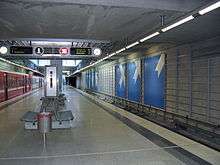
The U-Bahn (Metro) line U2 serves the airport at the Flughafen station. Trains connect the airport with the centre of the city every 10 to 15 minutes. The ride to the Hauptbahnhof (Central Railway Station) and the nearby Altstadt (historic old town) only takes 12 minutes.
Car
Nuremberg Airport is located 5 km (3.1 mi) north[2] of the city centre. It is accessible via nearby Motorway A 3, which connects to Motorway A 9 as well as Motorways A 73 and A 6. Taxis are available around the clock and take around 15 minutes to get to the city centre. Furthermore, rental car companies Avis, Hertz, Europcar and Sixt are located in the arrival hall.
Bus
A bus stop is located centrally in front of terminal 1 (entrance to departure hall 2). Bus number 32 connects the airport with bus and tram stop Thon between 5 a.m and 12 a.m.
Since December 2015 new line 33 was installed, allowing passengers from Nurembergs west-neighbouring city Fürth getting to the airport quicker without taking a detour via Nuremberg Central Station.
Because of the airport's close-in location and its direct connections to local streets, it is also possible to walk or ride a bicycle from nearby neighborhoods right up to the terminal.
Environment
In addition to developing strategies to reduce noise pollution the department also implements regular measurements of air pollutants and soil analyses. In 2003, a biomonitoring campaign with honey bees was launched at the airport.[22]
The water collected on the 70 ha of sealed or covered areas is being filtered and analyzed before it gets fed into receiving water courses, to prevent pollution due to oils or fuels. If the analyzed TOC value is above the threshold level, the water is discharged into the sewerage. Over the years, surface and aircraft de-icing fluids have been replaced by substances with higher biodegradability.
Expansion plans
Airport Business Center
In 2009, it was decided that a new hotel with conference rooms and offices will be built at the airport roundabout. ConTech GmbH and the architect's office Christ, both from Nuremberg, will realize the project with investor ZBI.[23] In 2011 the plans were put on hold until the motorway connection is completed.
Motorway access
Direct access to motorway A3 has been planned for several years. A direct route to the airport with a tunnel under the runway to reduce traffic through city district Ziegelstein is favored and spatial planning has already been completed. However, further planning has been delayed as environmental organization Bund Naturschutz and alliance Nein zur Flughafen-Nordanbindung! are vehemently against the plans.
Accidents and incidents
- On 8 January 2010, an Air Berlin Boeing 737-800 skidded off the runway shortly before takeoff on a flight to Düsseldorf, causing the airport to close for a few hours.[24][25]
See also
References
Citations
- ↑ http://www.br.de/nachrichten/mittelfranken/flughafen-nuernberg-rueckgang-100.html
- 1 2 3 EAD Basic
- ↑ http://www.airport-nuernberg.de/259223/Flugplan_NUE_Sommer_2013.pdf airport-nuremberg.de – Summer 2013 schedule
- ↑ Press release no. 02/08 from 17 January 2008 Airport Nürnberg Voted ‚Best German Airport'
- ↑ Press release no. 01/09 from 16 January 2009 Airport Nürnberg: 'Best German Airport' – More Passengers
- ↑ http://airliners.de/air-berlin-streicht-touristik-drehkreuz-in-nuernberg/29329
- ↑ http://www.br.de/nachrichten/mittelfranken/inhalt/albrecht-duerer-flughafen-nuernberg-name-100.html
- ↑ http://www.aero.de/news-25138/Ryanair-bringt-sich-als-Air-Berlin-Alternative-ins-Gespraech.html
- ↑ rbb-online.de - "Air Berlin wants to cancel nearly 500 staff nationwide" (German) 14 October 2016
- ↑ http://www.airliners.de/germania-basis-airport-nuernberg/39918
- ↑ http://www.airport-nuernberg.de/english/passengers/parking
- ↑ http://www.fai.ag/ambulance/fai_ambulance.html
- ↑ http://www.airport-nuernberg.de/flight-schedule
- ↑ http://www.airberlin.com
- ↑ http://www.aero.de/news-25071/Eurowings-benennt-erste-Palma-Ziele.html
- 1 2 3 4 https://www.flygermania.com/de/fluginformation/streckennetz/
- 1 2 3 4 http://www.routesonline.com/news/38/airlineroute/268259/germania-s17-service-expansions-update-1/
- 1 2 3 http://www.routesonline.com/news/38/airlineroute/269210/ryanair-expands-nuremberg-network-in-s17/
- ↑ https://aeroportodoporto.wordpress.com/2016/09/21/birmingham-e-nuremberga-regressam-em-marco/ in Portuguese
- ↑ "WizzAir boosts Belgrade service from May 2017". routesonline.com. Retrieved 2 September 2016.
- ↑ "WizzAir expands Tuzla operations in S17". routesonline.com. Retrieved 2 September 2016.
- ↑ "Monitoring of airborne pollutants". www.airport-nuernberg.de. Retrieved 22 February 2011.
- ↑ Press release from 28 May 2009 http://www.airport-nuernberg.de/english/company/press/press2009/art3017,11192
- ↑ "Flughafen Nürnberg nach Unfall wieder in Betrieb". Süddeutsche Zeitung. Retrieved 9 January 2010.
- ↑ http://www.focus.de/panorama/welt/wetter-flughafen-nuernberg-nach-unfall-wieder-in-betrieb_aid_469138.html
Bibliography
- Bernd Windsheimer: 50 Jahre Airport Nürnberg 1955–2005. Geschichte der Luftfahrt in Nürnberg, Nürnberg 2005
External links
![]() Media related to Nuremberg Airport at Wikimedia Commons
Media related to Nuremberg Airport at Wikimedia Commons
- Official website
- Current weather for EDDN at NOAA/NWS
- Accident history for NUE at Aviation Safety Network